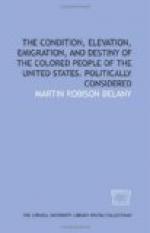Whatever may be our pretended objections to any place, whenever and wherever our oppressors go, there will our people be found in proportionate numbers. Even now could they get possession of the equatorial region of South America, there would colored men be found living on their boats and in their houses to do their menial services; but talk to them about going there and becoming men, and a thousand excuses and objections are at once raised against the climate or whatever else.
The writer, within the past few years, and as early as seventeen years ago, then being quite young, and flushed with geographical and historical speculations, introduced in a Literary Institution of Young Men, the subject of Mexican, Californian, and South American Emigration. He was always hooted at, and various objections raised: one on account of distance, and another that of climate.
He has since seen some of the same persons engage themselves to their white American oppressors—officers in the war against Mexico, exposing themselves to the chances of the heat of day and the damp of night—risking the dangers of the battle-field, in the capacity of servants. And had the Americans taken Mexico, no people would have flocked there faster than the colored people from the United States. The same is observed of California.
In conversation, in the city of New York, a few weeks ago, with a colored lady of intelligence, one of the “first families,” the conversation being the elevation of the colored people, we introduced emigration as a remedy, and Central America as the place. We were somewhat surprised, and certainly unprepared to receive the rebuking reply—“Do you suppose that I would go in the woods to live for the sake of freedom? no, indeed! if you wish to do so, go and do it. I am free enough here!” Remarking at the same time, that her husband was in San Francisco, and she was going to him, as she learned that that city was quite a large and handsome place.
We reminded her, that the industry of white men and women, in four years’ time, had made San Francisco what it is. That in 1846, before the American emigration, the city contained about seven hundred people, surrounded by a dense wilderness; and that we regretted to contrast her conduct or disposition with that of the lady of Col. Fremont, a daughter of Senator Benton, who tenderly and indulgently raised, in the spring after his arduous adventure across the mountains, and almost miraculous escape, while the country was yet a wilderness, left her comfortable home in Missouri, and braved the dangers of the ocean, to join her husband and settle in the wilderness. That she was going now to San Francisco, because it was a populous and “fine city”—that Mrs. Fremont went, when it was a wilderness, to help to make a populous and fine city.




